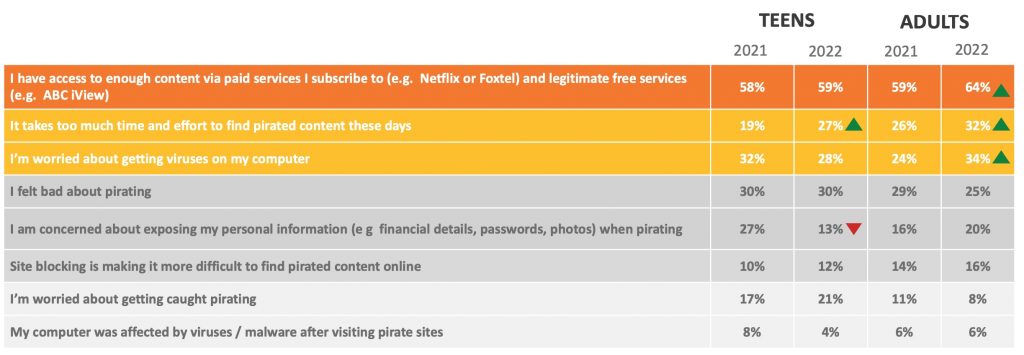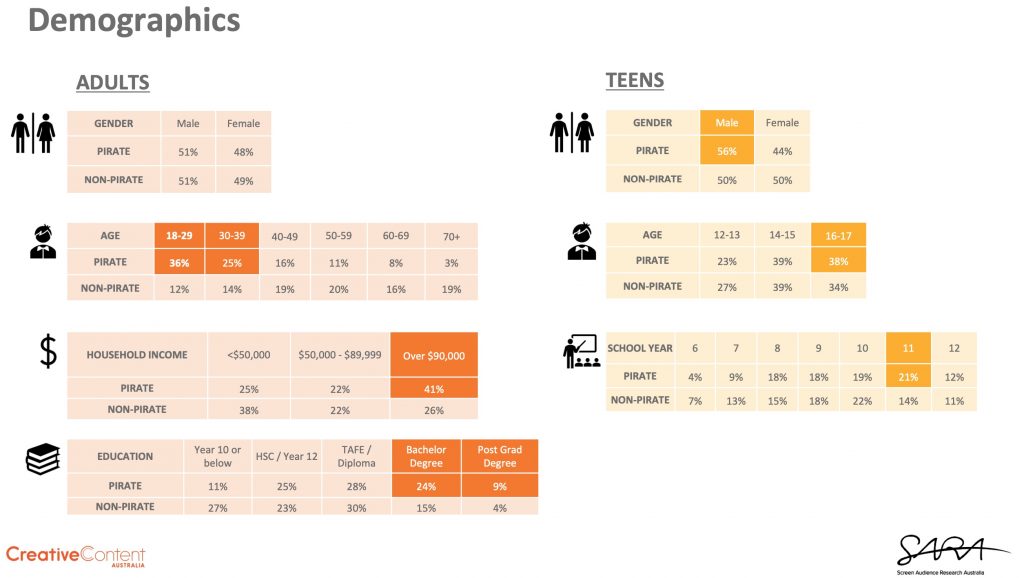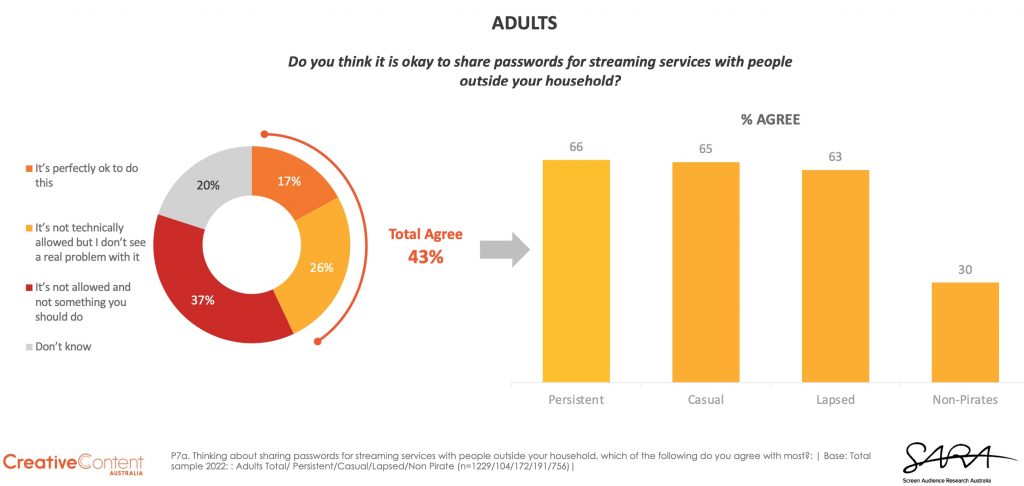 Active piracy rates among adults 18 years of age and above was 21% in 2022, virtually unchanged compared with 2021, according to research released by the industry group Creative Content Australia (CCA) in May 2023. It was a slightly different story among teens aged 12-17: while those who self-identified as Active Pirates went from 24% to 23%, those self-identifying as Non-Pirates increased by 6%.
Active piracy rates among adults 18 years of age and above was 21% in 2022, virtually unchanged compared with 2021, according to research released by the industry group Creative Content Australia (CCA) in May 2023. It was a slightly different story among teens aged 12-17: while those who self-identified as Active Pirates went from 24% to 23%, those self-identifying as Non-Pirates increased by 6%.
The survey segmented each consumer group into four categories: Persistent pirates accessed illegal sources at least once per week, Casual pirates accessed them monthly or less, Lapsed pirates no longer do it, and Non-pirates have never done it.
For the Adult group, the availability of content through legitimate distribution channels, the amount of time and effort needed to access illegal sources, and virus concerns were the main reasons for lower piracy rates. For teens, the amount of time to find pirate content was the greater deterrent. Teens were also less concerned about exposure of their personal information in 2022, versus 2021.

The likelihood of being caught was not seen as a major deterrent for either age bracket.
Demographic differences
While one might expect that people with lower economic means to buy programming through legitimate distribution channels and those less educated might be the ones with the highest rates of piracy, the opposite was the case.

A third more consumers in the over-AU$90K income bracket (41%) admitted piracy than those who did not (26%), and those with Bachelors and post-grad degrees were also significantly higher than non-pirates in those categories.
Greater role for social media
Viewing of content from illegal sources among teens has shifted from the Web to social media. “Pirate consumers are bypassing search engines and going right to pirate sites based on exposure in social media channels because people trust and accept the recommendations made there,” said Amy Pettinger, General Manager of Creative Content Australia.
Many pirate operators use social media to promote their sites. “They invite consumers to join private Facebook groups or use Facebook Live to play trailers and include links to the pirate sites or cyberlockers themselves and present up-sells to premium tiers that consumers pay for to unlock,” she said.
The CCA study bears this out: the percentage of Active Pirate adults seeking recommendations for pirate sites through social media channels went from 9% to 13% between 2021 and 2022, and more than doubled for Casual Pirate adults between 2021 (5%) and 2022 (11%).
Interestingly, only 38% of those who admit to viewing video programming through a social media platform self-identified as pirates. More than half self-identified as non-pirates and the remainder didn’t know whether they were pirates or not.
Site blocking
According to CCA, changes in Australian copyright law to permit site blocking has brought piracy rates down, but this decrease has been largely offset. While 11% of consumers turn to legal sources, 29% look to other pirate sources.
The percentages of survey respondants who adopted alternate DNS services went from 16% in 2020, to 25% in 2022, while the percentages using VPNs went from 24% to 40% respectively. “One reason is that it’s easy to find threads on Reddit and elsewhere that tell you how,” said Ms. Pettinger. Both are well-recognized tools for piracy and pirates.
Password sharing
Those who classified as pirates were more likely to share passwords. The surprise was in the differential: pirates were more than twice as likely than non-pirates, to share.

Piracy deterrents
Consumer awareness of cyber-attacks and advertising campaigns have both acted as piracy deterrents. Two of Australia’s best known brands – including the Internet provider Optus and the health insurance provider Medibank – have created a lot of awareness and made cybercrime a higher government priority there.
72% of adults and 82% of teens surveyed – including both active and lapsed pirates – reported being impacted by a cybersecurity issue.
Methodology
The research was conducted via a nationwide online survey by Screen Audience Research Australia. Between October 12 and 24, 2022, n=629 teens aged between 12 and 17 responded. n=1,229 Adults aged 18 and above responded between September 27 and September 30, 2022.
Note: In Australia, consumers classify as pirates, no matter whether or not they are re-distributing illegal instances of content or services. In other jurisdictions, only those who re-distribute illegally (e.g. those without distribution rights or permission) are considered to be pirates.
Read the full report
Australian Piracy Behaviours and Attitudes. 2022 Wave 14 Adults and Wave 9 Teens. Research report (PDF). Released May 2023. Creative Content Australia.
Other meaningful take-aways
Early in the COVID pandemic period between 2020 and the present, piracy rates increased around the world, including in Australia. In retrospect though, the 2020 piracy peak did not last. In 2021-2022, it stabilized.
The number of available legitimate streaming services, as they launched in Australia, has contributed both to the amount of content being stolen and to the increasing percentages of content being accessed through legal channels.
One of the piracy channels that’s receiving an increasing level of awareness is piracy that occurs through apps, which has in turn increased interest and demand for app and data protection technologies by media companies and distributors. This Australia consumer study bolsters the argument: 66% of adults surveyed thought that if they were paying for an app or streaming service, that it must be legal. This would imply that consumers are likely to trust fraudulent apps and sites, although fraud detection was not considered in this study.
Unsurprisingly, demand was highest for new movie releases and new TV shows among consumers in both age groups, followed by older releases of each, and then foreign language content. But surpisingly, overseas sports content was just 4% among adults and 8% among teens, and just 3% and 4% respectively for Australian sports content. Contrast that with demand for sports content in Europe, the Americas or in South Africa, where one might move the decimal point to the left by a decimal place and then multiply.












